Hapkido and Taekwondo Knife Defense


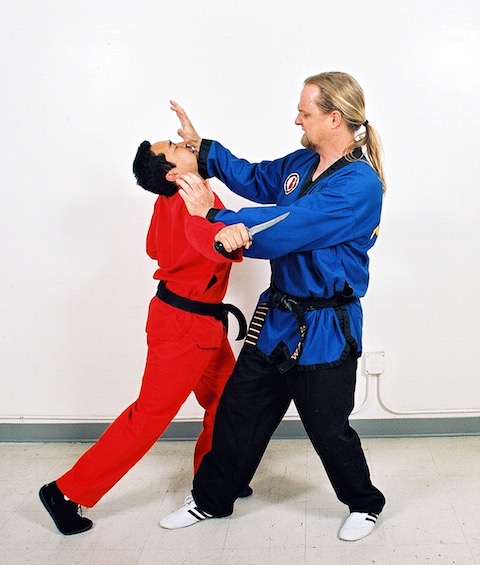
Hapkido and Taekwondo Knife Defense
Don’t Get Stuck
Self-Defense Against the Knife Attack
This article originally appeared in the April 1995 issue of Inside Karate Magazine.
By Scott Shaw
As random acts of violence have continued to grasp all aspects of modern society, we as competent martial artists must continually refine our methods of self-defense in order to successfully protect ourselves and those we love if the need ever arises. The knife has long been one of the leading weapons of aggressive offensive behavior. It is for this reason, we must place the knife at the forefront of our study of overall self-defense, so we will not fall victim to its potentially deadly attack.
Whenever an opponent comes at you with a knife, you must immediately assume they mean you harm. With this understanding in mind, you must instantaneously launch into the most effective and powerful self-defense possible to save yourself from potential injury.
Understanding Knife Self-Defense
To begin the study of self-defense against the knife, you must first fully understand that unlike other weapons, such as a club, a knife has the potential to injure you, from any position, until your opponent has been completely disabled. For example, if you simply try to recklessly grab a hold and wrestle with your opponent’s knife wielding hand, he can easily shift the direction of the knife and cut you. For this reason, it is of paramount importance, in knife self-defense, that you must first learn how to effectively intercept your opponent’s knife holding arm and then immediately take control of his movements so he will not have the potential to injure you.
Interception of an opponent’s knife holding hand is the first step that will lead to your overall control of the altercation. This is, however, the most difficult thing to successfully accomplish because of the fact your opponent will generally keep his knife holding hand in motion as he is attacking you.
The interception of the knife holding hand must take place as close to the inception of the altercation as possible, for with each passing moment your opponent has the ability to injure you with his knife.
Two Pathways
There are two pathways to intercepting the arm of a knife-wielding opponent. One: is to rapidly move in and encounter the arm of your opponent before he has the opportunity to stab in your direction. The second is for you to encounter your opponent’s stabbing motion, as the knife is traveling towards you, and take control of it. Though, if performed improperly, either one of these knife-intercepting pathways could prove dangerous. The second application is potentially much more hazardous, however, as the knife is in motion. To this end, it is to your advantage to move in and take control over your opponent’s knife holding arm before he ever begins a stabbing technique.
Instigating Self-Defense
As stated, the moment you are accosted by a knife holding attacker is when you must take immediate action. For example, if your opponent has just located himself in front of you and is standing with a knife ready to be launched in your direction, threatening you, this is your ideal opportunity to move in towards him and take control of the altercation. You must do this before the attack escalates and the advantage substantially moves to your attacker.
To effectively achieve knife defense with a stationary opponent, you must not try to grab randomly in the direction of his hand holding the blade. This is because, if he sees your oncoming motion and slightly shifts the knife, you hand could be easily cut. It is a far better initial form of knife defense if you take control of him by other, more refined, means.
One of the best and simplest way to effectively encounter a stationary ‘knife holding’ opponent is to rapidly move in towards him, allowing your lead leg to slide you forward. As you precisely move in towards him, you move slightly to his outside, angling your body out of the direct pathway of the knife. Simultaneously as you move in, you extend your lead arm with an Open Palm. With this Open Palm lead-in, you impact to the outside forearm of your opponent’s knife holding arm. Once you have made contact, you powerfully shove his forearm tightly against his body. This will give you initial control over his motions. As this lead-in technique will only control your adversary momentarily, you must immediately deliver a devastating blow to keep him from regaining his footing and launching a secondary knife attack at you. The type of strikes which would be most appropriate, are a Straight Punch to his temple or a Knife Hand to his throat with your free hand.
Another effective method to encounter a stationary knife-wielding opponent is to rapidly move in and joint lock his knife holding arm. This can be successfully accomplished by, again, allowing your forward leg to rapidly guide you in towards your opponent. As you do so, you have your forward arm move in and deflect his knife holding arm outwards. This is achieved by making your lead-in hand into a Knife Hand. You move in and strike to your opponent’s inner forearm region, with a forty-five degree Knife Hand technique or a forearm block. This will effectively drive his knife holding arm outwards and away from you. Once this initial deflection is made, you must immediately continue forward with additional controlling maneuvers. Immediate ongoing self-defense is a necessity because once you have begun your defense; your opponent will no doubt be much more agitated and will attempt to cut you.
Joint Locking
For advanced practitioners, you can also use joint locking techniques to defeat a knife-wielding opponent. To achieve this end you would once again rapidly move in on your opponent as previously describe. Once his knife-wielding arm has been put in check you would follow up with a joint locking technique.
To utilize the least amount of energy in this knife defense technique you should follow through with your initial inside deflecting path and allow your lead-in arm to slide rapidly downward, along the knife holding arm of your opponent. This will check his arm and keep him from stabbing at you as you continue forward with your technique. As you step in closer to him, you immediately send your deflecting arm under and then over the top of his arm. This forces his knife holding arm to extend out straight. You continue forward with this technique and you locate your arm to the rear elbow region of your opponent.
By powerfully forcing downward on this hold, to his elbow, you lock his entire arm. Thus, he will not be able to launch a secondary attack at you.
Knife in Motion
Though taking control over a knife possessing opponent before he ever moves his blade forward to attack you is the ideal circumstance, it is not always possible. For this reason, you must learn to successfully defend against a knife attack, once the blade is in motion.
There are a few consistent paths a knife attacker will generally take when attempting to stab at you. If we isolate these movements we can, thereby, learn how best to deal with each of them.
Shoulder Movement
One of the key things to watch for whenever an attacker has accosted you with a knife is his shoulder movement. Your opponent will generally move his shoulder, on the side that possesses the knife, just before he actually sends the knife forward. This shoulder movement take place either because your opponent uses this motion to recoil his knife backwards just a small amount before he launches it forward with additional momentum or he will slightly move his shoulder to realign himself, to better frame the path of his knife attack. In either case, movement in your opponent’s shoulder is the clue to watch for when a knife attack is at hand. Once you observe this shoulder motion, this is your time to prepare for the oncoming blade.
When an opponent stabs towards your mid-section with a low level knife attack, it is imperative you keep the knife as far away from your body as possible. To achieve this, you must meet the forward thrusting attack of the knife as close to its point of inception as possible. To do this you can effectively encounter your opponent’s knife trusting arm with a Cross Wrist Block as you additionally arch your back outwards, at your lower spine level. This arching will give you added distance between your stomach and the blade. The Cross Wrist Block is accomplished by crossing your two hands, in Knife Hand fashion, at your wrists, forming a firm arch. You send your knife blocking arms forward and downward at a forty-five degree angle, impacting your opponent to his knife-thrusting forearm. This will halt the onslaught of the blade.
Once this attack is blocked, you must immediately proceed through with additional measures to keep your opponent from refocusing and launching a secondary attack. Therefore, you instantly allow your block to slide back near your opponent’s knife-holding hand. From here, you reach in with your rear hand, (the one closest to his knife holding hand), and place your thumb to the central back portion of his hand. As you do this, your fingers powerfully wrap around his knife holding palm. Immediately, you arch his wrist unnaturally to the side and ninety degrees backwards, against itself. Thus, locking it. Now that you have taken control of his wrist, you can easily guide his arm by putting additional pressure to this wrist-lock. You extend his arm out straight. Then, you combine the wrist-lock with a powerful shove to the back of his elbow. His wrist, elbow, and thus his body are completely locked. He cannot continue on with his attack.
Targeting
Knife attacks are also commonly directed at either your mid-section or your head, by your opponent making sideways stabbing or slashing motions. The key to encountering this type of knife attack is to, again, meet your opponent’s oncoming arm motion as close to its point of inception as possible. By blocking the knife’s path as soon as possible, a sufficient amount of momentum will not have been developed by your opponent’s arm to keep the knife traveling through your block and, thus, making impact to your body.
For example, an opponent launches a head level, circular slashing knife assault. You instantaneously stop the knife’s progress by performing a Knife Hand, In-to-Out Cross Arm Block to your opponent’s inner forearm region. This will keep your blocking arm a sufficient distance away from the knife so it cannot easily shift and cut you. Once you have blocked the initial knife attack, immediately bring your free arm up and under, impacting it to the backside of your opponent’s attacking arm, just below his elbow. This will give you controlling leverage. With the arm you initially blocked with, you shove your opponent’s forearm back against itself. This will keep your opponent from having the ability to redirect the knife. With your bracing arm, take a hold of your opponent’s knife holding wrist from behind as you bend his arm back farther, unnaturally behind itself. You have now locked your opponent. He will not have the ability to launch a secondary knife attack.
Overhead, downward stabbing, knife assaults are also a common type of attack. Again, as in all forward moving knife assaults, you must block it as close to its point of inception as possible.
Your opponent attempts to stab you with an overhead attack. By immediately performing a Cross Body High Block to your opponent’s knife wielding forearm, you stop the motion of his oncoming knife. Once you have initially blocked it, you immediately place the middle finger of your free hand into his knife holding elbow joint. By reaching your thumb around the bottom of his elbow, you take a powerful hold. This grabbing technique gives you powerful leverage. As you perform this grab, you simultaneously shove his arm back against itself, powerfully locking it. From this positioning you can effortlessly control your opponent.
As each type of knife attack is different, the specific type of defense you use must be designed to effectively deal with the path of the oncoming blade. Therefore, it is very important to study and practice the various methods of knife defense to keep yourself free from injure and victorious in the confrontation, if you are ever attacked by a knife wielding opponent.
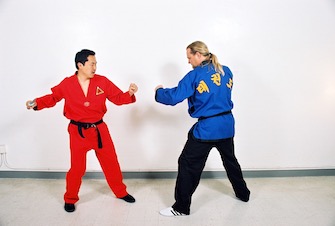
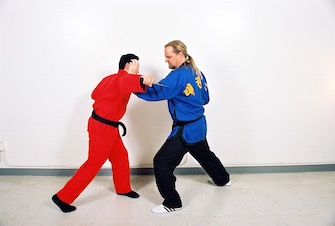
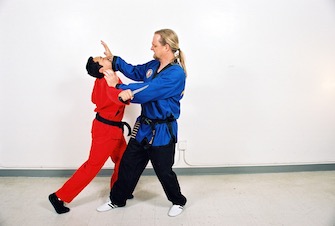
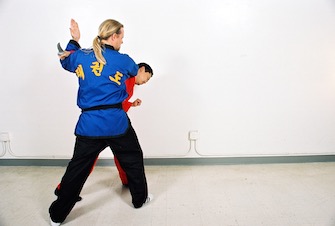
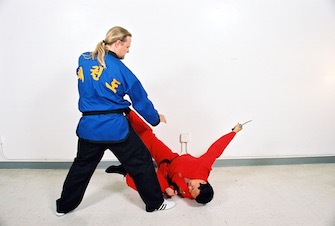
Copyright © 1995 — All Right Reserved